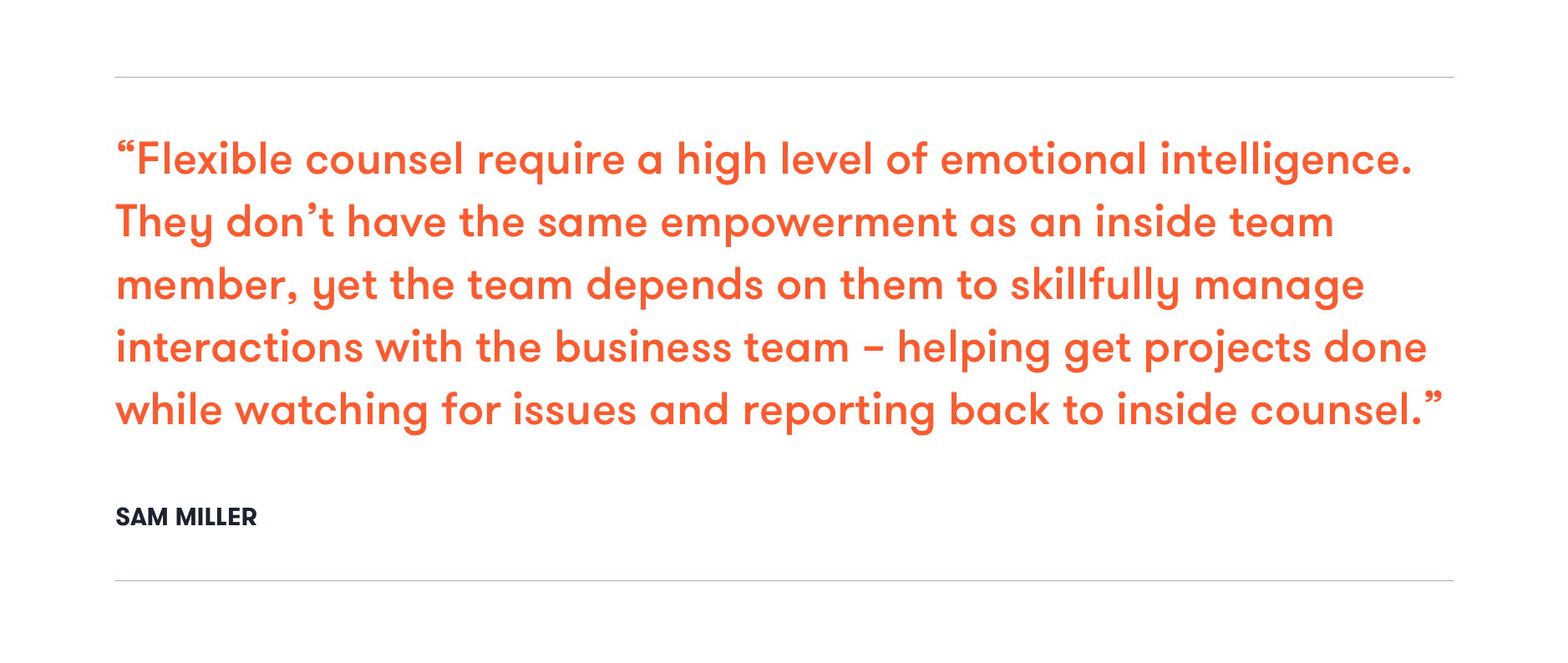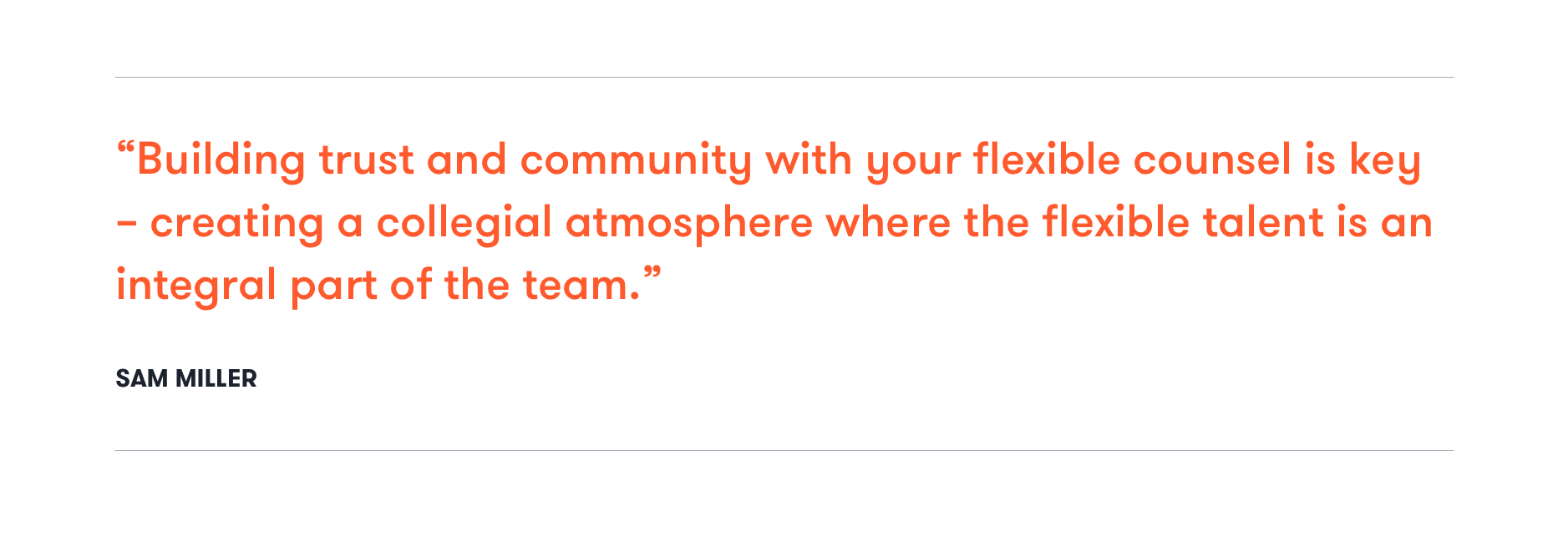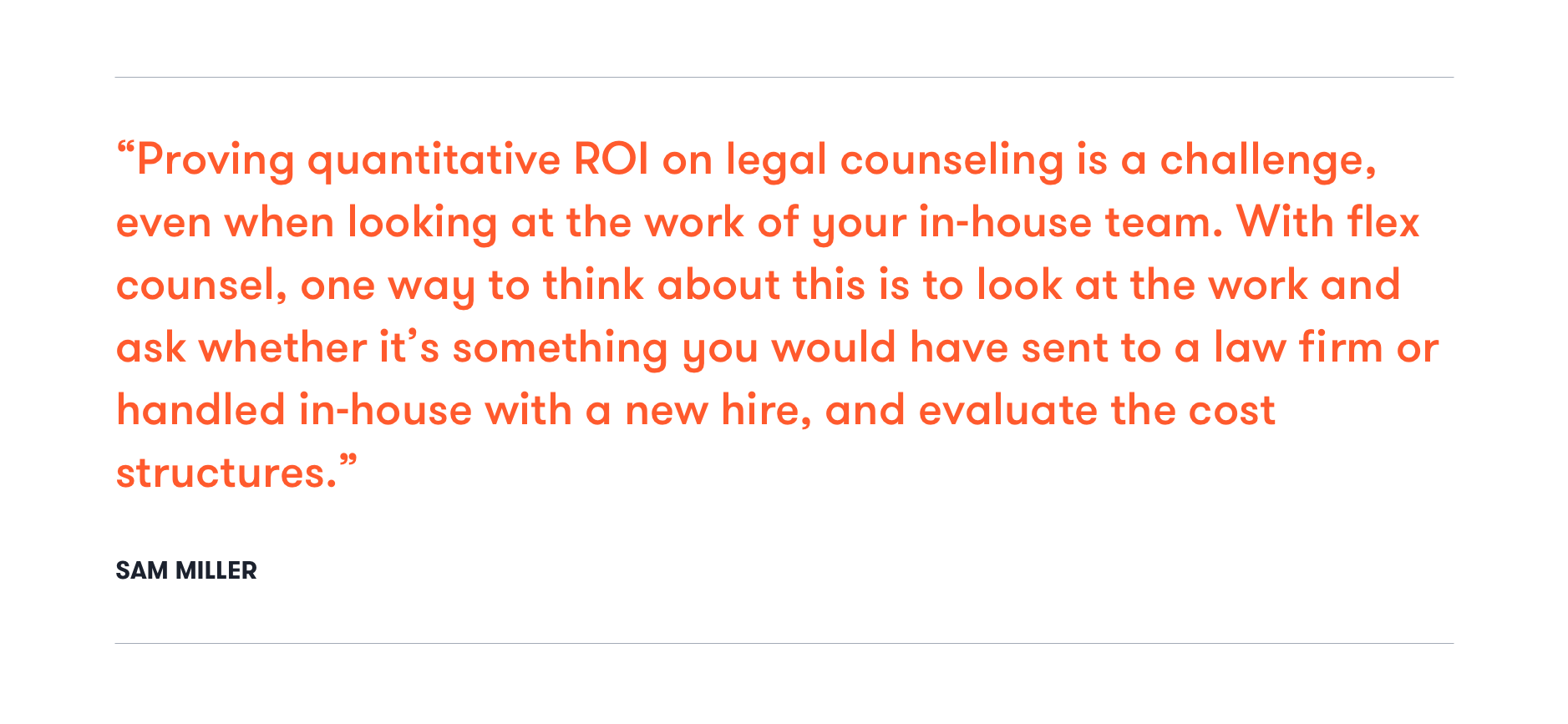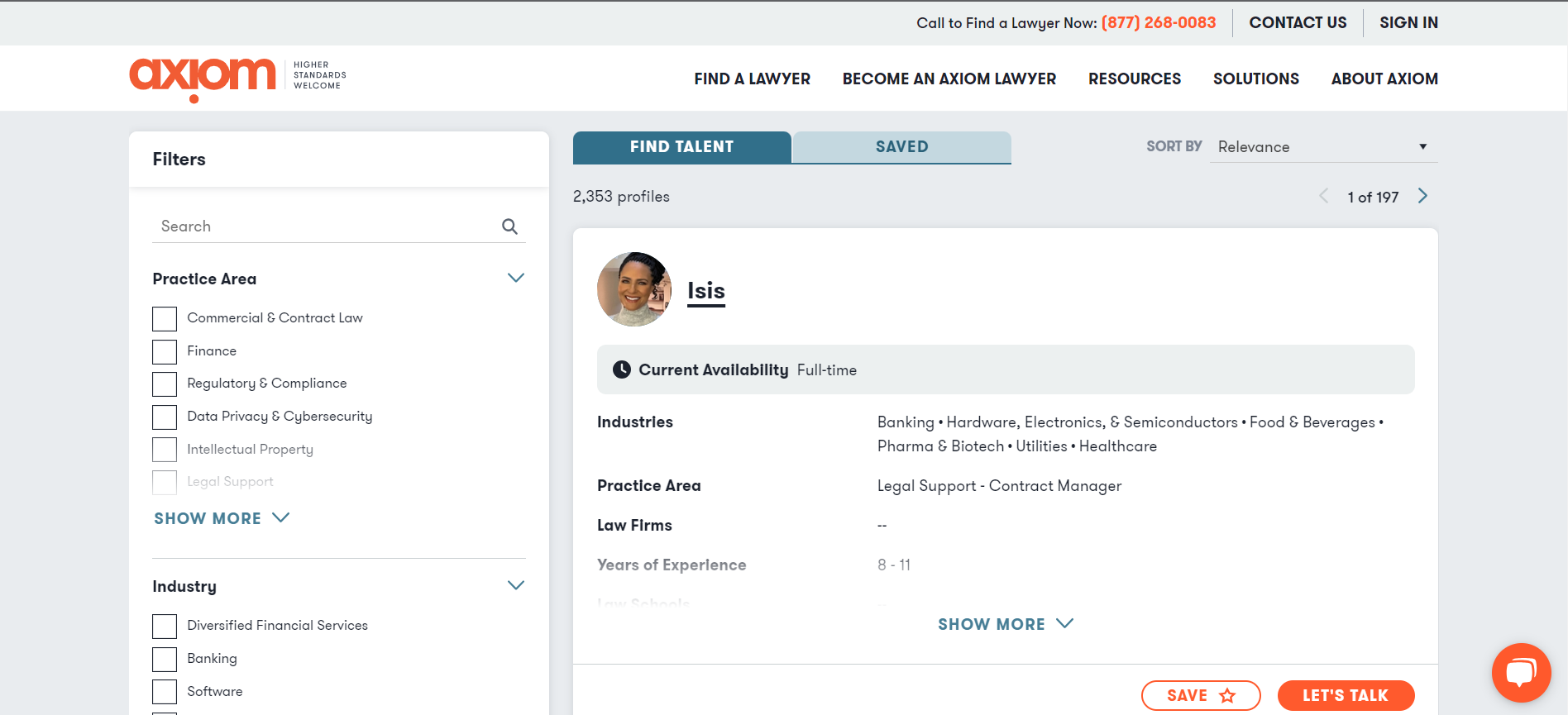Integrating Flexible Legal Talent into Your Team: Implementation Best Practices
July 2023
By
Axiom Law

In the first article of our series, Using Flexible Talent to Build a Resilient Legal Organization, legal advisor, executive consultant, and former Intel DGC Sam Miller outlined why access to high-quality flexible legal talent is a necessary tool for in-house leaders looking to create resilient, responsive legal teams.
In this article, the second of our series, we cover how to incorporate flexible talent into legal resourcing strategies, outlining the key steps GCs must take to drive successful outcomes for the department and business teams.
 Sam outlines her strategic approach to successfully launch and sustain a flexible talent function, including:
Sam outlines her strategic approach to successfully launch and sustain a flexible talent function, including:
- Enlisting internal support and participation
- Identifying the right flex talent and integrating them into your team’s workflow
- Creating an environment that helps flex counsel succeed
- Measuring impact and building on positive results
When you decided you wanted to bring in flexible counsel, who else did you need to involve in the decision and implementation?
My primary focus was on enrolling my internal legal team. They were the ones who would be working most closely with the flex counsel, and it was critical that the internal team saw flex counsel as an asset, versus just creating more work or replacing internal lawyers. At first, we all had a fair amount of skepticism. The breadth of available flex counsel wasn’t what it is today, and we weren’t sure we could find the right skill set. We’d had success with sole practitioners playing a similar role, so I knew the potential was there. It was a matter of finding the right lawyer. I worked with my flex provider, and we eventually identified a person with a very high level of relevant experience through Access Legal Talent. Then I engaged someone on my team who I knew had a resource need and might be open to trying out the model. Once we had that success, we added a second flex lawyer. Then flex counsel became an accepted part of our resource planning process, and it grew from there.
Other key stakeholders you may need to engage – depending on your role, organizational structure, and particular circumstances – are the GC, finance, and the business teams. For these stakeholders, I recommend focusing on:
- The high quality of legal support from flex counsel;
- The value proposition of a flex firm fee profile;
- The benefits of being able to quickly adjust support up and down as the workload changes.
As a side note, business teams who have requested more support and buy into the model can sometimes help fund the flex counsel role.
 What made a flex counsel lawyer a good fit for your team? What are the strategies you used to clarify the skills you needed flexible counsel to bring to your team?
What made a flex counsel lawyer a good fit for your team? What are the strategies you used to clarify the skills you needed flexible counsel to bring to your team?
I started by listing out the “soft” skills I wanted, such as (1) someone I can throw into anything; (2) someone who can work independently and without a lot of guidance; and (3) someone with a general level of seniority at least a level higher than the role might require. Then I layered the substantive legal skills on top of that through the Find A Lawyer platform’s filter function. For my initial flexible talent hire, I looked for a fairly senior person with extensive, broad-based experience; solid, substantive chops; an enterprise perspective; and no ego.
That may sound like “overhiring,” but it is very helpful for flex roles. Flexible counsel require a high level of emotional intelligence. They don’t have the same empowerment as an inside team member. Yet, the team depends on them to skillfully manage interactions with the business team – helping get projects done while watching for issues and reporting back to inside counsel. Flexible counsel must also be a cultural fit for your team – meaning they can play the role outlined above while fitting into your particular company culture.
How do you effectively integrate flex counsel into your team?
Recognize that when you bring on a flex counsel as a "stand-in" for traditional in-house counsel, it’s a tricky position for them to navigate – they aren’t in a traditional outside counsel role, but they also aren’t an employee. They are expected to engage directly with businesspeople while being more limited in what they’re actually empowered to do.
Flexible counsel need insight into what’s happening in the business to do the kind of proactive, business-first lawyering that businesspeople have come to expect from their in-house lawyers. They also need to understand the boundaries and guardrails around their scope of responsibility. It’s useful to create a version of a “new hire” training plan for your flex counsel – slimmed down to match the scope of what you need them to be doing.
Once they’re on board, it’s good to make sure they’re getting updates on relevant developments within the company. Building trust and community with your flexible counsel is key – creating a collegial atmosphere where flexible talent is an integral part of the team. Invite them to your staff meetings and ensure they have regular 1:1 check-ins with whoever on your team is managing them.
Can you elaborate on why it’s important to create that kind of environment for flex counsel, and how you went about it?
My goal for flex counsel was similar to that for inside counsel and our traditional law firm teams – to create a work environment that maximizes what the team can achieve. That requires an environment where people enjoy working and want to stay. It’s not enough to just bring people in and give them interesting work. Like everyone, lawyers want community and growth. I consciously created a team feeling for the flex counsel I was working with – ensuring they were part of the legal team and the business group they were supporting, as well as with each other.
Beyond building a sense of community, check in with your flexible team members. Ask them how the work is going and if they are fulfilled, and think about whether there are any tweaks you need to make so you get more of what you need from them and they stay happy and engaged in the work. It’s less time than you spend with an in-house employee, but just as crucial. The quality of the experience for both sides goes down significantly, and the outcomes can suffer, if you and your flex counsel are not engaged in regular communication.
 How did you evaluate the impact and value of working with flex counsel?
How did you evaluate the impact and value of working with flex counsel?
The never-ending quest to measure the legal counseling ROI! There's the obvious question of: Were we able to accomplish the task we hired them to do?
For a more detailed analysis, I took a two-step approach to assess the qualitative value of flex talent: (1) Were they meeting the needs of my internal team?; and (2) Did the business get the same high-quality legal support it would have gotten with internal counsel?
Asking the internal team to evaluate the flex counsel gives those team members who are individual contributors an opportunity to work on their “manager” skills. It’s a good training ground for them to analyze the work product and decide whether the person is performing at the level we want. Topics we covered included:
- Are the flex team members a net positive on workload?
- Are they ramping quickly?
- Are they meshing with the legal team?
- Is the work meeting our high standards?
- Are there changes you’d want to make to the program?
- If you brought the flex counsel in specifically to free up an in-house team member to tackle a project, that is another qualitative data point you may want to capture – were they able to accomplish that, and what is the value to the company?
Looking at whether flexible counsel meets the needs of internal business units provides another opportunity for team members to participate in the management duties, asking questions such as:
- How is their support going?
- Are people being responsive?
- Are they getting the creativity and quality that they need?
Proving quantitative ROI on legal counseling is a challenge, even when looking at the work of your in-house team. With flex counsel, one way to think about this is to look at the work and ask whether it’s something you would have sent to a law firm or handled in-house with a new hire, and evaluate the cost structures. A good flex provider can help you gather and analyze qualitative performance as well as budget information, especially as your program scales.
 What started with one lawyer eventually grew to many. As the demand for flex counsel increased, how did you scale in a way that balanced the benefits of flexibility and continuity of this kind of support?
What started with one lawyer eventually grew to many. As the demand for flex counsel increased, how did you scale in a way that balanced the benefits of flexibility and continuity of this kind of support?
The composition and size of the business, legal department, and support requirements are going to dictate the extent to which you scale up the size of a flex talent program, and with Axiom’s Access Legal Talent, you can browse flex counsel with those filters in place. My advice on best practices to keep in mind are:
Start small: Pilot the concept with clear success criteria before rolling out across the department.
Focus on fit: If someone is not a fit for the team, move quickly to another solution.
Make investments: Take the time to develop a strong relationship with a flexible talent provider. Having an established and trusted relationship with a flex firm makes a big difference in your ability to quickly and easily flex this capability up and down. A good flex provider will get to know you, your team, and your company’s business really well, which informs their ability to identify the desired hard and soft skills in a potential lawyer. When a need materializes, you will be able to move faster, and the entire engagement will go more smoothly.
Build a trusted bench: Over time, you will build up a stable of vetted flex talent, which makes it easier and faster to tap into as your needs ebb and flow. With each rotation or new assignment, the flex counsel’s ramp-up time decreases, as does the amount of time your internal team needs to spend training them, creating an increasing return on your investment. Prioritizing your existing bench when new needs arise provides consistency that incentivizes flex counsel to stay longer-term.
Create your own roster: People tend to want to work with lawyers who have proven their ability to perform well in the department, and who carry the endorsement of their peers. We created an internal site for my team members to get information about the flex lawyers we were working with, including information about where they worked, who they worked with, and what kind of matters they had covered.
Plan for growth: If your program becomes really large, consider designating an internal team member to play a central implementation role for flexible talent who can:
- Understand the nature of the business unit that needs support, as well as the overall business
- Look broadly at the flexible talent available and help identify the right person for the right work
- Help oversee the relationship with the flex provider, including engagement and financial management, as well as identification of continuous improvement or co-innovation opportunities
Thoughtfully implementing a flex counsel program will maximize the benefits to your organization and allow you to continually build on your successes, leading to increased return on investment over time. Start small, define and measure success, focus on culture fit, and invest time in your flex talent partnership to build the foundation that will keep your in-house legal department agile and ready to meet the needs of your organization.
To work with a trusted flexible talent provider, check out our platform to find lawyers that fit well with your team and match all your project needs.
About Sam Miller: Sam Miller is a legal advisor, executive consultant, and former DGC at Intel with nearly three decades of experience working at the intersection of law, business, and technology. At Intel she held a breadth of roles, including VP and Corporate Secretary, VP and DGC of Global Business Legal, and General Counsel of Intel Capital (Intel’s investment arm). Sam works with a broad range of companies and nonprofit organizations, and is a board member at the Law Foundation of Silicon Valley, the Minority Corporate Counsel Association, and the Oshman Family JCC.
Get the guide
* Required
Posted by
Axiom Law
Related Content
Why Strategic Use of Flexible Talent Should Be Part of a GC’s Toolkit
Sam Miller, legal consultant and former Deputy General Counsel of Intel, discusses why flexible counsel can be a powerful tool for legal department leaders in part one of our series on building a resilient legal organization.
It’s Time to Rethink Legal Talent
The general counsel’s guide for how to clear the path for a more flexible, efficient and cost-effective legal ecosystem.
Maintaining a Resilient Legal Function During a Downturn
Sam Miller, former DGC of Intel, discusses leading through uncertainty and how legal leaders can make the most of their resources.
It’s Time to Rethink Legal Talent
Posted by Axiom Law- Expertise
- North America
- Legal Department Management
- Must Read
- Perspectives
- Work and Career
- State of the Legal Industry
- Legal Technology
- Spotlight
- Solutions
- Artificial Intelligence
- Regulatory & Compliance
- United Kingdom
- Data Privacy & Cybersecurity
- General Counsel
- Legal Operations
- Australia
- Central Europe
- Commercial & Contract Law
- DGC Report
- Labor & Employment
- Regulatory Response
- Technology
- Banking
- Commercial Transaction
- Diversified Financial Services
- Hong Kong
- Intellectual Property
- Investment Banking
- Large Projects
- News
- Singapore

